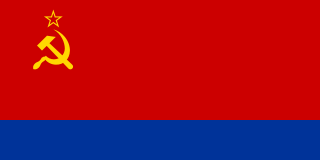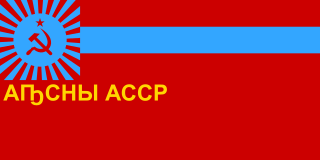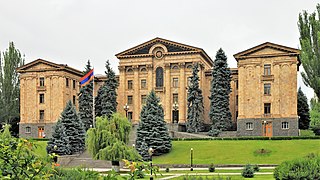Related Research Articles

The Moldavian Soviet Socialist Republic or Moldavian SSR, also known as the Moldovan Soviet Socialist Republic, Moldovan SSR, Soviet Moldavia, Soviet Moldova, or simply Moldavia or Moldova, was one of the 15 republics of the Soviet Union which existed from 1940 to 1991. The republic was formed on 2 August 1940 from parts of Bessarabia, a region annexed from Romania on 28 June of that year, and parts of the Moldavian Autonomous Soviet Socialist Republic, an autonomous Soviet republic within the Ukrainian SSR.

The Transcaucasian Socialist Federative Soviet Republic, also known as the Transcaucasian Soviet Federative Socialist Republic, or simply Transcaucasia, was a republic of the Soviet Union that existed from 1922 to 1936.

The Azerbaijan Soviet Socialist Republic, also referred to as the Azerbaijani Soviet Socialist Republic, Azerbaijan SSR, Azerbaijani SSR, AzSSR, Soviet Azerbaijan or simply Azerbaijan, was one of the constituent republics of the Soviet Union between 1922 and 1991. Created on 28 April 1920 when the Russian Soviet Federative Socialist Republic brought pro-Soviet figures to power in the region, the first two years of the Azerbaijani SSR were as an independent country until incorporation into the Transcaucasian SFSR, along with the Armenian SSR and the Georgian SSR.

The national flag of Armenia, also known as the Tricolour, consists of three horizontal bands of equal width, red on the top, blue in the middle, and orange on the bottom. The Armenian Supreme Soviet adopted the current flag on 24 August 1990. On 15 June 2006, the Law on the National Flag of Armenia, governing its usage, was passed by the National Assembly of Armenia.

The Nakhichevan Autonomous Soviet Socialist Republic, abbreviated as Nakhichevan ASSR was an autonomous republic within the Azerbaijan SSR, itself a republic within the Soviet Union. It was formed on 16 March 1921 and became a part of the Azerbaijan SSR proper on 9 February 1924.

The National Assembly, also transliterated as Milli Mejlis, is the legislative branch of government in Azerbaijan. The unicameral National Assembly has 125 deputies: previously 100 members were elected for five-year terms in single-seat constituencies and 25 were members elected by proportional representation; as of the latest election, however, all 125 deputies are returned from single-member constituencies.

The Abkhaz Autonomous Soviet Socialist Republic, abbreviated as Abkhaz ASSR, was an autonomous republic of the Soviet Union within the Georgian SSR. It came into existence in February 1931, when the Socialist Soviet Republic of Abkhazia, originally created in March 1921, was transformed to the status of Autonomous Soviet Socialist Republic within the Georgian SSR.

The Act of the Re-Establishment of the State of Lithuania or Act of 11 March was an independence declaration by Lithuania adopted on 11 March 1990, signed by all members of the Supreme Council of the Republic of Lithuania led by Sąjūdis. The act emphasized restoration and legal continuity of the interwar-period Lithuania, which was occupied by the Soviet Union and annexed in June 1940. In March 1990, it was the first of the 15 Soviet republics to declare independence, with the rest following to continue for 21 months, concluding with Kazakhstan's independence in 1991. These events led to the dissolution of the Soviet Union in December 1991.

The Declaration of State Sovereignty of the Byelorussian Soviet Socialist Republic was a formal document issued by the Supreme Soviet of Belarus to assert its independence from the Soviet Union. Passed on July 27th, 1990, the declaration started the process of Belarus' eventual independence on August 25th, 1991.

The Declaration "On the Restoration of Independence of the Republic of Latvia" was adopted on 4 May 1990 by the Supreme Soviet of the Latvian SSR in which Latvia declared independence from the Soviet Union. The Declaration stated that, although Latvia had de facto lost its independence in 1940, when it was annexed by the Soviet Union, the country had de jure remained a sovereign country as the annexation had been unconstitutional and against the will of the Latvian people.

The Ministry of Foreign Affairs of Armenia (MFA) is a state body of executive power, which elaborates and implements the foreign policy of the Government of Armenia and organizes and manages diplomatic services. The MFA acts accordingly to the Constitution and legislation of Armenia. The Ministry of Foreign Affairs coordinates the activities of the executive power bodies of the Republic in the international arena. Since 2021, Ararat Mirzoyan has been the Minister of Foreign Affairs of Armenia.

The Estonian Sovereignty Declaration, fully: Declaration on the Sovereignty of the Estonian SSR, was issued on 16 November 1988 during the Singing Revolution in the Estonian SSR. The declaration asserted Estonia's sovereignty and the supremacy of the Estonian laws over the laws of the Soviet Union. Estonia's newly elected parliament also laid claim to all natural resources: land, inland waters, forests, mineral deposits and to the means of industrial production, agriculture, construction, state banks, transportation, municipal services, etc. within Estonia's borders.

The Russian Soviet Federative Socialist Republic, previously known as the Russian Soviet Republic and the Russian Socialist Federative Soviet Republic, and unofficially as Soviet Russia, was an independent federal socialist state from 1917 to 1922, and afterwards the largest and most populous constituent republic of the Soviet Union (USSR) from 1922 to 1991, until becoming a sovereign part of the Soviet Union with priority of Russian laws over Union-level legislation in 1990 and 1991, the last two years of the existence of the USSR. The Russian SFSR was composed of sixteen smaller constituent units of autonomous republics, five autonomous oblasts, ten autonomous okrugs, six krais and forty oblasts. Russians formed the largest ethnic group. The capital of the Russian SFSR and the USSR as a whole was Moscow and the other major urban centers included Leningrad, Stalingrad, Novosibirsk, Sverdlovsk, Gorky and Kuybyshev. It was the first socialist state in history.

An independence referendum was held in the Armenia SSR on 21 September 1991 to determine whether to secede from the Soviet Union. It followed a declaration of independence on 23 August 1990. 99.5% of voters voted in favour, with a turnout of 95%. The country officially became an independent state on 23 September 1991.

The Union of Soviet Socialist Republics (USSR) was formally dissolved as a sovereign state and subject of international law on 26 December 1991 by Declaration № 142-Н of the Soviet of the Republics of the Supreme Soviet of the Soviet Union. It also brought an end to the Soviet Union's federal government and General Secretary Mikhail Gorbachev's effort to reform the Soviet political and economic system in an attempt to stop a period of political stalemate and economic backslide. The Soviet Union had experienced internal stagnation and ethnic separatism. Although highly centralized until its final years, the country was made up of 15 top-level republics that served as the homelands for different ethnicities. By late 1991, amid a catastrophic political crisis, with several republics already departing the Union and Gorbachev continuing the waning of centralized power, the leaders of three of its founding members, the Russian, Belorussian, and Ukrainian SSRs, declared that the Soviet Union no longer existed. Eight more republics joined their declaration shortly thereafter. Gorbachev resigned on 25 December 1991 and what was left of the Soviet parliament voted to dissolve the union.

The Declaration and Treaty on the Formation of the Union of Soviet Socialist Republics officially created the Union of Soviet Socialist Republics (USSR), commonly known as the Soviet Union. It de jure legalised a political union of several Soviet republics that had existed since 1919 and created a new federal government whose key functions were centralised in Moscow. Its legislative branch consisted of the Congress of Soviets of the Soviet Union and the Central Executive Committee of the Soviet Union (TsIK), while the Council of People's Commissars composed the executive.

The Declaration of Independence of Azerbaijan is the pronouncement adopted by the Azerbaijani National Council meeting in Tiflis on 28 May 1918, declaring the independence of the Azerbaijan Democratic Republic.
Estonian Restoration of Independence, legally defined as the Restoration of the Republic of Estonia, was proclaimed on 20 August 1991. On that day at 23:02 local time, the Supreme Council of the Republic of Estonia, in agreement with the Estonian Committee, declared the illegal Soviet occupation and annexation of the country terminated, and proclaimed the full restoration of the independence of Estonia.
Committee for State Security of the Armenian Soviet Socialist Republic or KGB of ArSSR was the security agency of the Armenian Soviet Socialist Republic, being the local branch of Committee for State Security of the USSR. It was the principal intelligence agency of Armenia from 1954 to 1991. It was succeeded by the National Security Service after the collapse of the Soviet Union. The KGB in Armenia often provided undercover agents to be stationed inside the Armenian Apostolic Church, due to the church's prevalence in the country. The Armenian KGB fell under the direct control of the Central Committee of the Communist Party of Armenia, although the Communist Party of the Soviet Union could take control and also direct its activities.

The Supreme Soviet of the Armenian SSR, later renamed as the Supreme Council of the Republic of Armenia, was the Supreme Soviet of the Armenian Soviet Socialist Republic and later the independent Republic of Armenia. It was superseded by the National Assembly in 1995 when Armenia adopted the Armenian Constitution.
References
- ↑ Declaration of Independence Armenica
- ↑ Armenian Declaration of Independence Republic of Armenia